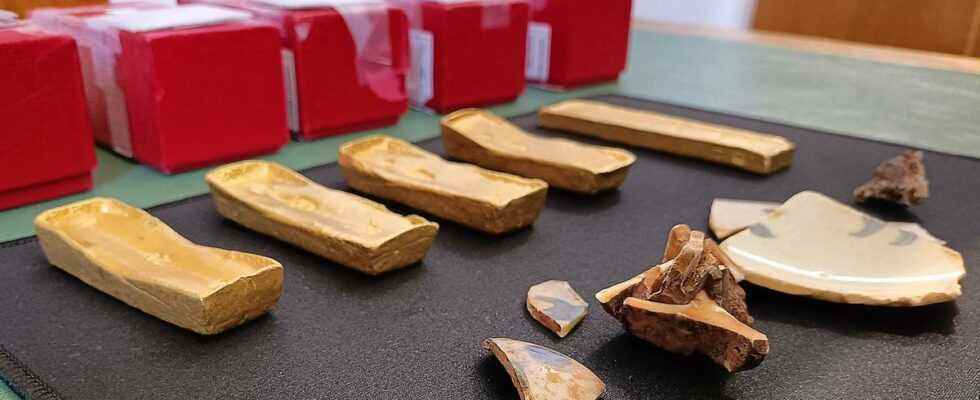Sunk in 1746, the Prince of Conty finds himself at the heart of an international judicial inquiry. Three suspects have been indicted for the theft and concealment of the treasure of this French ship.
Three people have been indicted for the concealment of gold bars looted from a French wreck of 1746, which had then been illegally sold in the United States before their return to France, the Brest prosecutor’s office announced on Wednesday June 15.
Five ingots, worth some 230,000 US dollars (220,000 euros), from the cargo of the Prince de Conty reappeared on the catalog of a Californian auction house, which planned to put them up for auction in early 2018. Alerted by the French authorities, the American authorities seized them and returned them to France during a ceremony at the beginning of March in Washington.
Read alsoThe Clooney Foundation calls for the looting of antiquities to be punished as a war crime
On May 18, three French people were “indicted on the counts of concealment of cultural property resulting from theft committed by an organized gang, money laundering by an organized gang, criminal association and illegal export of cultural property”, announced at a press conference the public prosecutor of Brest Camille Miansoni.
The three people, a couple and a woman, have been placed under judicial supervision and face up to 15 years of criminal imprisonment, he said, adding that the investigation was continuing, because looted objects are still at the stranger. An American couple, linked to the three respondents, has also been identified by the investigators.
“Major cultural establishments of international renown, in particular the British Museum, acquired from persons belonging to the identified group, and still held them, ingots and objects from the wreck of the Prince de Conty”, assured Camille Miansoni. “The requests for restitution transmitted, in particular to the British Museum, have remained to this day, curiously and with regret, unsuccessful”, he added.
SEE ALSO – Discover the first images of the wreckage of Ernest Shackleton’s Endurance found off Antarctica
Read alsoBritish Museum open to deal with Greece to share Parthenon marbles
The British Museum is already at odds with Greece over marbles from the Parthenon of the Acropolis in Athens, which the country has been asking for for many years to be returned. Chance of the calendar, the prestigious museum said Wednesday open to an agreement with Athens.
Chinese ingots
When taken into custody, the couple admitted their involvement “in the recovery of ingots and also their sale in Switzerland and the United States”, while the woman denied any involvement, according to Camille Miansoni. The man indicted is a former professional photographer diver already suspected, but exonerated, in a trial held in 1983 in Lorient in a case of looting of the same wreck, a ship of the Compagnie française des East Indies.
Returning from the Far East, this sailboat was shipwrecked on December 3, 1746, on a stormy and foggy night, near Belle-Ile-en-Mer (Morbihan). Of the 229 men on board, only 45 survived. Immersed in 10 to 15 meters deep, in an area of strong currents and particularly difficult to access, the wreck had fallen into oblivion until its discovery in 1974 by a teacher. It was then looted, before a professional expertise which observed thousands of fragments of Chinese porcelain from the reign of Emperor Qianlong (1736-1795), remains of tea crates and three small Chinese gold ingots.
Read alsoIn Cannes, experts and authorities warn of the looting of wrecks
The five stolen ingots and the few fragments of porcelain objects were officially returned on Wednesday June 15, during the press conference at the Department of Underwater and Underwater Archaeological Research (Drassm), the service responsible for inventorying submerged heritage. in France.
“Today, having these remains that enter public collections is a real satisfaction”reacted Olivia Hulot, maritime archaeologist at Drassm. “The ships of the Compagnie des Indes are a special page in our maritime history”, she underlined, specifying that the remains of only one of them, the Prince of Conty, had been found for the time being along the French coasts.
The restored ingots are decorated for some of Chinese ideograms symbolizing prosperity. They were used as currency by China to buy goods from France.
SEE ALSO – Unpublished images of the wreck of the legendary galleon San José unveiled by Colombia
